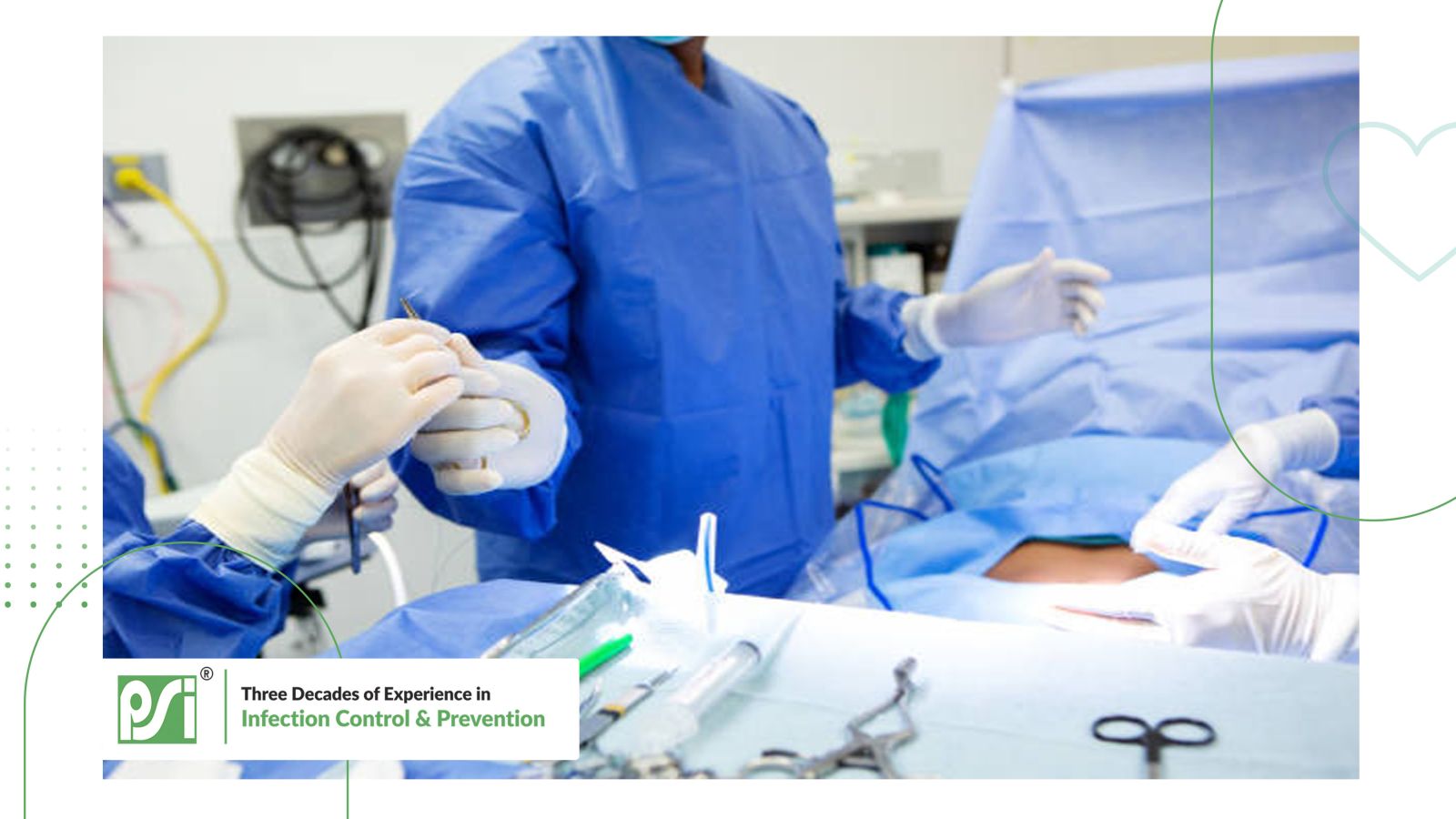One of the best Surgical Disposables company. I am dealing with them for the past 5 years,
their products are world-class. Their approach to trade is professional. All the best wishes to
them.
Precision in the OR: Exploring Gynaecology Caesarian Drapes
- By: Plasti Surge Industries

Gynecology Cesarean Drapes, often referred to as surgical drapes or sterile drapes, are specialized medical textiles designed for use in gynecological and obstetric surgeries, particularly during Cesarean sections (C-sections). These drapes are made from sterile materials and are precisely engineered to create a sterile barrier, ensuring that the surgical area remains free from contaminants. Gynecology Caesarian Drapes typically feature adhesive edges, fenestrations (openings), and fluid collection pouches, all of which contribute to maintaining a sterile surgical environment, protecting both the patient and the medical team from potential infections. They play a vital role in infection control and surgical precision during gynecological procedures.
Gynecology Caesarian Drapes play a pivotal role in surgical procedures, with a particular focus on ensuring the safety and precision of C-sections. These specialized drapes are essential components of sterile surgical setups, providing a barrier against contaminants and maintaining a sterile field. During C-sections, where both the mother and the newborn's well-being are at stake, the use of Gynaecology Caesarian Drapes helps reduce the risk of infections and ensures that the surgical team can perform the procedure with utmost precision. These drapes contribute significantly to maintaining hygiene and minimizing complications, ultimately promoting successful surgical outcomes. For high-quality Gynaecology Caesarian Drapes, visit PSI Disposables.
The Role of Caesarian Drapes in Infection Control
Gynecology Caesarian Drapes are vital components of maintaining sterility during surgical procedures, especially during C-sections. They create a protective barrier, preventing the introduction of contaminants into the surgical site. Infection prevention in the operating room is of paramount importance, as it directly impacts patient safety and surgical outcomes. In the case of C-sections, preventing infections is crucial for both the mother and the newborn. Surgical site infections can lead to complications and prolonged hospital stays. Gynecology Caesarian Drapes serve as a crucial defense against such risks, ensuring that surgical teams can work within a sterile environment, minimizing infection risks, and promoting positive patient outcomes.
Key Features and Components
- Adhesive Areas: These drapes typically have adhesive edges that securely attach to the patient's skin, creating a barrier against contaminants.
- Fenestrations: Gynaecology Caesarian Drapes often come with precise, pre-cut fenestrations or openings. These fenestrations are strategically placed to allow access to the surgical site while maintaining the overall sterility of the drape.
- Fluid Collection Pouches: Many drapes include fluid collection pouches or reservoirs to capture any fluids or contaminants that may be generated during the surgical procedure. This feature helps keep the surgical field dry and clear.
- Reinforcement Material: Some drapes incorporate reinforcement material around the fenestrations and adhesive areas, ensuring durability and preventing tearing during surgery.
- Translucent Film: The drape material is often made from a translucent film that allows the surgical team to clearly see through the drape, facilitating precise incisions and suturing.
- Incise Films: In some cases, incise films are integrated into the drape. These films have antimicrobial properties and help maintain a sterile environment during the surgery.
- Tube Holders: Gynaecology Caesarian Drapes may have tube holders or straps to secure surgical instruments or medical tubing in place during the procedure.
These features collectively contribute to the effectiveness of these drapes in maintaining sterility and ensuring the success of gynecological surgeries, particularly C-sections.
Materials and Sterility
Here's a tabular breakdown of the materials used in manufacturing Gynaecology Caesarian Drapes and the sterilization processes involved:
|
MATERIALS USED |
STERILIZATION PROCESS |
|
Non-Woven Polypropylene |
Ethylene Oxide (EO) Gas Sterilization |
|
Adhesive Films |
Gamma Irradiation |
|
Absorbent Layers |
Steam Sterilization (Autoclaving) |
|
Incise Films (If Included) |
Electron Beam Sterilization |
|
Reinforcement Material |
Hydrogen Peroxide Gas Plasma Sterilization |
These materials are carefully selected and combined to ensure the drapes are not only effective in maintaining sterility during surgical procedures but also safe for patient use. Sterilization processes vary based on the materials used, with each method chosen for its compatibility and efficacy in achieving a high level of sterility.
Customization and Sizing
 Gynecology Caesarian Drapes are designed with customization in mind to accommodate various patient sizes and surgical requirements. Proper sizing is paramount for their effective use in C-section procedures. Here's why customization and sizing matter:
Gynecology Caesarian Drapes are designed with customization in mind to accommodate various patient sizes and surgical requirements. Proper sizing is paramount for their effective use in C-section procedures. Here's why customization and sizing matter:
-
Patient Comfort and Safety: Drapes should fit the patient snugly to ensure their comfort during the procedure. A well-fitted drape minimizes discomfort and potential movement, reducing the risk of infection or complications.
-
Infection Prevention: Proper sizing ensures that the drape covers the patient precisely, creating a barrier against contaminants. This is vital for maintaining a sterile surgical environment and preventing postoperative infections.
-
Procedure Flexibility: Different C-section procedures may require specific access points or incisions. Customized drapes can be designed with fenestrations or adhesive areas tailored to the surgical plan, allowing for greater flexibility and precision.
-
Optimal Fluid Control: Customized drapes can include fluid collection pouches or reinforcements in areas prone to fluid exposure, enhancing the overall control of fluids during surgery.
-
Waste Reduction: When drapes are appropriately sized, there is less material waste, promoting sustainability in healthcare practices.
In summary, the ability to customize Gynaecology Caesarian Drapes ensures that they meet the unique needs of each patient and surgical scenario, contributing to patient safety, infection prevention, and surgical precision.
Benefits of Gynecological Surgeries
Gynecology Caesarian Drapes are indispensable in gynecological surgeries, particularly C-sections. They create a sterile environment, safeguarding against infections. With specialized features like adhesive areas and fenestrations, they allow surgeons precise access while maintaining sterility. These drapes optimize surgical procedures, ensuring safety and effectiveness in gynecological operations.
Gynecology Caesarian Drapes play a pivotal role in safeguarding the sterile field during surgical procedures, ensuring the safety of both patients and medical staff. By creating a barrier against contaminants and providing a sterile environment, these drapes minimize the risk of infections, particularly crucial in gynecological surgeries like C-sections. Their adhesive areas and fenestrations allow for precise access while maintaining sterility, enhancing the overall safety and effectiveness of the procedure. As a result, these drapes are indispensable tools that contribute significantly to the well-being of patients and the success of gynecological surgeries.
Quality Standards and Regulations
The manufacturing and use of surgical drapes, including Gynaecology Caesarian Drapes, are subject to stringent standards and regulations to ensure patient safety and the effectiveness of surgical procedures. These standards are typically established by medical authorities and organizations like the FDA (Food and Drug Administration) in the United States or the CE (Conformité Européene) marking in Europe. They encompass various aspects, including material quality, sterilization methods, and performance criteria.
Adherence to these standards is of paramount importance as it ensures that the drapes are manufactured under controlled conditions, maintaining their sterility and integrity. Compliance also guarantees that the materials used are biocompatible and safe for patient contact. Non-compliance can lead to contamination risks, compromised patient safety, and even legal consequences for healthcare facilities and manufacturers. Therefore, strict adherence to these standards is crucial to maintaining the high safety and effectiveness required in surgical settings.
In India, the manufacturing and use of surgical drapes are regulated by several authorities and standards to ensure patient safety and the effectiveness of surgical procedures. Some of the key standards and regulations include:
-
Indian Pharmacopoeia (IP): The IP is a reference book that contains standards for drugs that are marketed in India. While it primarily focuses on pharmaceuticals, it also includes guidelines related to medical devices, including surgical drapes.
-
Bureau of Indian Standards (BIS): BIS is the national body responsible for standardization and certification in India. They may specify standards for medical textiles and surgical drapes.
-
Medical Device Rules (MDR), 2017: These rules were introduced to regulate medical devices in India. Surgical drapes fall under the category of medical devices, and manufacturers must comply with the MDR, which outlines requirements for registration, licensing, and quality standards.
-
ISO Standards: Many surgical drapes manufacturers in India aim for compliance with international standards, such as ISO 13485 (Quality Management System for Medical Devices) and ISO 10993 (Biological Evaluation of Medical Devices), to ensure the safety and efficacy of their products.
-
Hospital Infection Control Guidelines: In addition to national standards, hospitals and healthcare facilities often have their own infection control guidelines that specify the use of sterile surgical drapes to maintain aseptic conditions during surgery.
It's important for manufacturers and healthcare facilities in India to adhere to these standards and regulations to ensure that surgical drapes are of high quality, safe for patient use, and effective in maintaining sterility during surgical procedures. Compliance also helps in preventing healthcare-associated infections and ensures patient safety.
Considerations for Healthcare Facilities
When procuring Gynaecology Caesarian Drapes, healthcare facilities should consider factors such as the drape's size, adhesive quality, fenestrations, and fluid collection capabilities to ensure they meet the specific needs of their surgical procedures. Additionally, verifying that the drapes comply with relevant standards and regulations, including those from national authorities and international organizations like ISO, is crucial for patient safety. Collaborating with reputable suppliers and conducting quality assessments can help healthcare facilities make informed decisions and provide the best care for patients during gynecological surgeries, especially C-sections.
When healthcare facilities are choosing Gynaecology Caesarian Drapes, several factors need consideration:
-
Quality: The quality of the drapes is paramount. They should be made from materials that are durable, sterile, and resistant to fluids, ensuring optimal performance during surgeries.
-
Supplier Reliability: Collaborating with a reliable supplier is crucial. Ensure that the supplier has a proven track record of delivering high-quality, compliant products consistently.
-
Customization: The ability to customize drapes to fit different patients and surgical needs is essential. This ensures that each procedure is carried out efficiently and safely.
-
Compliance: Check if the drapes meet the standards and regulations set by Indian healthcare authorities, including those from organizations like the Bureau of Indian Standards (BIS).
-
Cost-efficiency: While quality is crucial, cost-efficiency is also a factor to consider. Balancing quality and cost ensures that healthcare facilities can provide the best care while managing budgets effectively.
By carefully evaluating these factors, healthcare facilities can make informed decisions when procuring Gynaecology Caesarian Drapes, ultimately benefiting both patients and medical staff.
Conclusion
Gynecology Caesarian Drapes are indispensable tools in modern healthcare, especially in surgical procedures like C-sections. Their role in maintaining sterility, preventing infections, and safeguarding both patients and medical staff cannot be overstated. As you embark on the journey of providing top-notch care, it's vital to choose drapes that adhere to stringent quality standards and regulations. We invite you to explore high-quality Gynaecology Caesarian Drapes from trusted suppliers like PSIDispo, whose commitment to excellence ensures that you're equipped with the best in the field. Visit our website to discover a range of options that prioritize patient safety and surgical precision.
One of the best companies to partner with. Very responsive and best product quality.
Good experience and corporation for many years. Timely services are provided.
We have been associated with PSI since more than 20 years now. They have superior products, prompt service & courteous people. Using PSI’s products in turn makes our customer happy and helps us to do more business. Overall truly delighted with their customer service.














_iCEz.jpeg)
 +91-7798800781
+91-7798800781

4eby.jpg)
anme.jpg)



